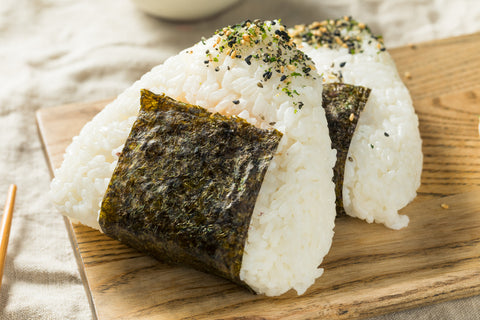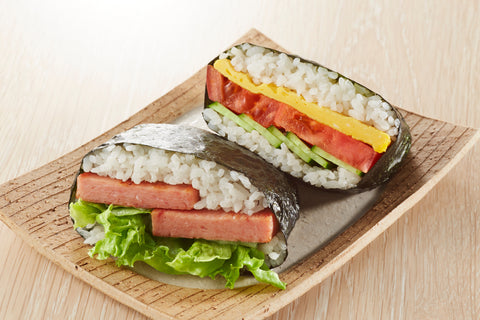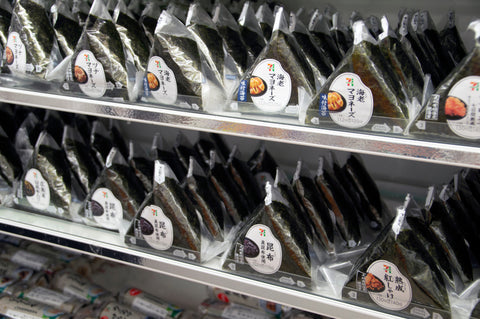Mastering Onigiri: The Art of Japanese Rice Balls
Onigiri, omusubi, nigirimeshi, and Japanese rice balls! These are all the different names used to refer to this traditional Japanese food made with steamed white rice and wrapped in a sheet of nori seaweed. Onigiri is often stuffed with fillings, which can be made with a variety of ingredients.
As one of Japan’s most popular snacks, you’ll find onigiri in homemade bento boxes and at picnics, festivals, hiking trips, cinemas, and street food stalls. The snack looks quite simple compared to classic meals like sushi, but it has an impressive cultural significance in Japan. For many of the locals, onigiri symbolizes family love and the act of kindness. It’s seen as a convenient and comforting food created to show affection to a friend, family member, or loved one.
In this post, we’ll explore all of the details surrounding onigiri. Get ready to learn about its origins, role in pop culture, common fillings, and basic recipe.
What is Onigiri? Unwrapping the Basics

Onigiri is a Japanese rice ball made of white rice, compressed into a triangular, round, or cylindrical shape, and wrapped in a nori sheet. Onigiri can contain only salt or a variety of ingredient fillings. Common fillings stuffed into onigiri are katsuobushi (dried bonito flakes), umeboshi (salted Japanese plums), grilled salmon flakes, konbu (edible kelp), and tarako (pollock roe). The wide variety of possible fillings makes these rice balls a versatile snack or meal.
Fillings have the biggest impact on the taste of onigiri, which could range from salty to sour. The snack's portable size and shape make it easy to carry around, particularly in a bento box.
Onigiri is sometimes mistaken for a type of sushi by people unaware of their differences. However, both foods are not in any way related. We’ll discuss their key differences later in this post. For now, let’s explore onigiri’s humble rise from a simple snack to a global staple.
The Historical Roots of Onigiri
Thanks to the excavation of carbonized rice grains in 1987, there is a theory that foods similar to onigiri were eaten around 2,000 years ago in Japan. Those lumps of rice were boiled or steamed and wrapped in bamboo leaves.
More concrete evidence, however, suggests that onigiri was invented during the Heian Period (794–1185). This version of the snack was quite different from what we know today. It was called ton-jiki, a spherical-shaped brown rice that was served to domestic servants during imperial events hosted by nobles. Back then, the rice balls were made out of glutinous rice. It was only after the Kamakura Period (around the 14th century) that ordinary rice became the main ingredient.
Onigiri slowly grew in popularity and usage, later becoming convenient food rations during the war times of the 15th and 16th centuries. People began to wrap onigiri in nori seaweed in the Edo Period (1603–1868), after which it became a popular bento at festivals and hanami (cherry blossom viewing) parties. It was also invaluable to travelers at the time. Hence, 1885 saw the first sales of bento lunches consisting of onigiri.
When convenience stores or konbini first opened in Japan during the 1970s, they struggled to make sales. Some of them began to sell onigiri, and that kickstarted their success stories. Today, Japan is home to some of the best convenience stores in the world, and most of them still sell onigiri. They’ve developed the packaging and recipes to create sumptuous modern-day variations such as the “onigirazu,” a sandwich-type snack that has grown extremely popular.
Today, onigiri is a staple food sold at Japanese specialty shops and restaurants worldwide. It rivals another staple meal in terms of popularity: sushi.
Onigiri vs. Sushi: Understanding the Differences

Despite similarities in their appearance, onigiri is not a type of sushi. Many people think so because they both contain rice and because there’s an existing sushi variant called “nigiri.” However, onigiri and sushi (or nigiri) have different preparation methods, flavors, and serving methods.
Onigiri is made using plain white rice, typically seasoned with salt, while sushi is made using rice seasoned with vinegar, salt, and sugar. Onigiri also doesn’t contain raw fish, unlike sushi. Their origins are also different. While onigiri was made to preserve rice and make it portable, sushi originated from the need to preserve raw fish.
The public perception of both meals in Japan is also different. Onigiri is seen as an ordinary, everyday food but sushi is considered a special meal eaten on unique occasions and is more expensive.
Onigiri in Japanese Pop Culture: From Manga to Movies

Onigiri’s iconic status in Japanese households extends into popular manga, anime, and films. There are countless references and appearances in modern media. However, below are some of our favorites:
One Piece: Zoro’s Sword Attack
In the first appearance of one of the anime’s coolest characters, Roronoa Zoro, he is starving and in dire need of help. A little girl named Rika offers him onigiri, which he greatly appreciates. In episode 7, Zorro uses his first sword attack, which he names ”oni giri,” loosely translating to “demon cutter,” but also a play on the word “onigiri,” which was the food that saved him. There’s obviously a connection there!
Cooking Papa: The Origin of Onigirazu
Cooking Papa was a popular manga series in the early 1990s, and it has had the greatest impact on onigiri among all pop culture references. Tochi Ueyama wrote the comic book, which told the story of Kazumi Araiwa, a husband and father who enjoyed cooking—though secretly.
One of Kazumi’s most creative dishes was a sandwich version of onigiri, which he named onigirazu. This was the first appearance of the modern variant, before it became popular in convenience stores and specialty shops.
Supermarket Woman: Hanako’s Onigiri Redemption Arc
A 1996 comedy, this movie focuses on Hanako, a supermarket expert who undertakes the gruelling task of saving Sho-jiki Ya. She notices that the section of the supermarket that sells onigiri has been making subpar products and attempts to get the man in charge to improve it. Hanako eventually convinces him, and together, they bring culinary joy to their customers.
Demon Slayer: The Act of Kindness and Sharing (Tanjiro and Zenitsu)
In episode 11 of the popular anime series, Tanjiro Kamado meets another demon slayer named Zenitsu while travelling on a mission. On the journey, there is a heartwarming scene where they both share the last ball of onigiri in their possession.
Popular Onigiri Fillings: A Guide to Classic and Contemporary Flavors

Let’s highlight a range of popular onigiri fillings you should try. Each one offers something unique to the beloved rice ball.
-
Salmon: If there’s one seafood that pairs perfectly with rice, it’s salmon. For onigiri, you can use salmon in a variety of ways. Our favorite is the salted salmon flakes. You can also use Ajishima Salmon Furikake Rice Seasoning to bring life to bland rice.
-
Umeboshi: Also known as pickled plum, umeboshi is one of the most common fillings for onigiri. The tangy and sour flavor complements the taste of plain rice.
-
Kombu: To use as filling, kombu is simmered in a rich broth of soy sauce, salt, sugar, mirin, and sake. It’s then chopped into thin pieces and stuffed into rice balls.
-
Katsuobushi: Many people prefer to use katsuobushi or bonito flakes mixed with soy sauce as their onigiri filling.
-
Tuna Mayo: A mixture of canned tuna and mayonnaise. This onigiri filling is one of the most popular in the world because of how well it pairs with plain rice and seaweed.
How to Make Onigiri: A Step-by-Step Recipe

Are you looking to make homemade onigiri? Follow our lead as we provide you with a basic onigiri recipe. You only need three key ingredients: rice, furikake seasoning (like the Ajishima salmon furikake we recommended above), and nori seaweed sheets. Once you assemble all of those ingredients, you can follow our guide below.
- Cook the rice with a cooker or stove and allow it to cool down to room temperature on a baking sheet. We’ll reveal the ideal rice recipes soon.
- Pour the cooked rice into a large bowl.
- Add furikake seasoning to the bowl of rice and mix thoroughly.
- Use a spoon to separate the seasoned rice mixture into multiple, equal-sized portions, approximately a handful each.
- Rub one or two pinches of salt between your palms to preserve rice and keep it from sticking to your hands during the next step.
- Pick a portion of rice and hold it in your hands. Don’t use paper towels.
- Optional: Make a small indent in the rice portion and place fillings into it, if available. Fold over the rice and press it.
- With the rice portion still on your palm, use your fingertips to squeeze parts of it and form a triangular shape.
- Place a sheet of nori under the rice portion, with the rough side facing the rice. Fold it across from one end to the other.
- You have your first onigiri. Now repeat steps 6 to 9 for the other rice portions and serve warm.
Mastering the Perfect Rice for Onigiri
Any rice that allows onigiri to shape easily is good for making the dish. Whichever rice you use should be tender and moderately sticky—just enough to maintain its shape. Japonica medium-grain or short-grain rice is an ideal choice, especially sushi rice. We highly recommend the Nishiki Premium Rice due to its high quality and versatility. Other sushi rice options are koshihikari rice and calrose rice. Do not use long-grained or glutinous rice.
To achieve the ideal texture, boil the medium- or short-grain white rice over high heat and stir occasionally. After a few minutes, reduce the heat to a low level and let the rice simmer for 15-20 minutes. Finally, limit the heat and allow the rice to steam for 15 minutes until it’s tender. Don’t forget to let it get cool enough to handle before using it for onigiri.
Wrapping Techniques: Nori and Beyond
There are two different methods for wrapping onigiri using nori seaweed sheets. The traditional method and the convenience store method. For the traditional method, cut the nori seaweed into strips and fold it around the shape of the onigiri. For the convenience store method, place one onigiri on the center of a nori sheet and fold the sides of the sheet over it. Next, use a band, parchment paper, or string to secure this wrapping and keep it fresh for longer.
Onigiri for Special Occasions: Festive and Creative Ideas

Onigiri does not need to have a triangular or cylindrical shape. People mold the snack into many other decorative shapes, especially on special occasions. Some make the onigiri round and draw cute faces by cutting the nori wrapped around it.
You could also pour bread crumbs on the rice and make a crispy, deep-fried variant. Another fun twist is to sprinkle seasonings like the Ajishima Shiso Japanese Perilla Furikake Rice Seasoning to give onigiri a unique look. Also, certain fillings are used for special occasions. For instance, cherry blossoms are popular onigiri fillings for hanami picnics.
Storing and Packing Onigiri for On-the-Go Snacking
Onigiri tastes best when you serve it within a few hours of making it. However, if you want it to ensure its freshness for your picnics and lunches, you should cover it in plastic wrap or seal it in an airtight container before placing it in the refrigerator. That way, your onigiri will remain fresh for about 24 hours.
Pairing Onigiri with Other Japanese Dishes
Let’s have a look at some complementary Japanese dishes and beverages that pair well with onigiri. For a complete meal experience, try eating your onigiri with the following pairings:
-
Pickled vegetables
-
Sparkling ume drink
-
Miso soup
-
Egg mixture, such as tamagoyaki
-
Fresh fruit
-
Sake
Onigiri Around the World: Global Takes on the Japanese Rice Ball
Modern onigiri is just as popular as the Arancini recipe (Italian rice balls typically made with mozzarella cheese, olive oil, bread crumbs, marinara sauce, and other Italian seasoning), Jumeok-bap (Korean rice balls made with minced beef and soy sauce), and other rice ball variants. Like them, it has become a universal snack that various cultures have embraced and adapted.
There are many specialty stores selling unique, international variations in the United States, France, and the rest of Europe. Global brands like Shirakiku are also creating rice balls that fuse traditional onigiri concepts with Asian cuisine. Check out their Kimchi & Cheese and Curry & Cheese grilled rice balls.
Where to Find Onigiri: From Convenience Stores to Specialty Shops

Finding ready-made onigiri in Japan is as easy as finding sand in the desert. They’re widely available in convenience stores, supermarkets, and specialty shops. These establishments tend to make affordable and high-quality onigiri. In the US, your search may become a little more difficult if you don’t know where to look. Thankfully, there are several Japanese convenience stores and shops that sell the snack.
If you prefer to make your own rice balls, trust Bokksu Market for authentic Japanese ingredients. We also offer different kinds of rice balls and other Asian snacks.
Why Onigiri Continues to Capture Hearts Worldwide
Thanks to its simplicity, versatility, and the joy it brings to both makers and eaters, onigiri will remain in the hearts of snack food lovers worldwide. People with dietary restrictions can eat onigiri since it doesn’t have to contain meat, fish, or dairy. As more people seek healthier snack options, Japanese rice balls will remain in high demand globally.
Author Bio








